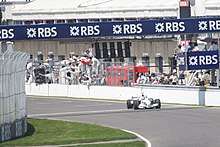
Back БМВ във Формула 1 Bulgarian BMW en Fórmula 1 Spanish BMW na Fórmula 1 Galician BMW dalam Formula Satu ID BMW in Formula 1 Italian BMW na Fórmula 1 Portuguese BMW în Formula 1 Romanian BMW в Формуле-1 Russian BMW in Formula One SIMPLE BMW v Formuli 1 Slovenian
 | |
| Full name | BMW Sauber F1 Team (2006–2009) |
|---|---|
| Base | Hinwil, Switzerland Munich, Germany |
| Noted staff | Mario Theissen Peter Sauber Willy Rampf Willem Toet Andy Cowell |
| Noted drivers | |
| Formula One World Championship career | |
| First entry | 1952 German Grand Prix |
| Races entered | 72 |
| Engines | BMW |
| Constructors' Championships | 0 |
| Drivers' Championships | 0 |
| Race victories | 1 |
| Podiums | 17 |
| Points | 308 |
| Pole positions | 1 |
| Fastest laps | 2 |
| Final entry | 2009 Abu Dhabi Grand Prix |
| Formula One World Championship career | |
|---|---|
| First entry | 1952 British Grand Prix |
| Last entry | 2009 Abu Dhabi Grand Prix |
| Races entered | 273 (270 starts) |
| Chassis | Frazer Nash, AFM, Balsa, Heck, Krakau, Nacke, Reif, Greifzu, Klenk, Lola, BMW, Brabham, ATS, Arrows, Benetton, Williams, BMW Sauber |
| Constructors' Championships | 0 |
| Drivers' Championships | 1 (1983) |
| Race victories | 20 |
| Podiums | 86 |
| Points | 1,021 |
| Pole positions | 33 |
| Fastest laps | 33 |

The German automobile manufacturer/brand BMW has been involved in Formula One in a number of capacities since the inauguration of the World Drivers' Championship in 1950. The company entered occasional races in the 1950s and 1960s (often under Formula Two regulations), before building the BMW M12/13 inline-four turbocharged engine in the 1980s. This engine was the result of a deal between BMW and Brabham, which resulted in the team's chassis being powered by BMW engines from 1982 until 1987, a period in which Nelson Piquet won the 1983 championship driving a Brabham BT52-BMW. BMW also supplied the M12/13 on a customer basis to the ATS, Arrows, Benetton and Ligier teams during this period, with various degrees of success. In 1988, Brabham temporarily withdrew from the sport and BMW withdrew its official backing from the engines, which were still used by the Arrows team under the Megatron badge. Turbocharged engines were banned by the revised Formula One Technical Regulations for 1989, rendering the M12/13 obsolete.
BMW decided to return to Formula One in the late 1990s by signing an exclusive contract with the Williams team, which needed a new long-term engine supplier after the withdrawal of Renault in 1997. The programme resulted in the creation of a new V10 engine which made its race début in the Williams FW22 in 2000. The following year saw the partnership move from the midfield to challenging for race victories, but the desired championship remained elusive due to the dominance of Michael Schumacher and Ferrari in the first half of the 2000s. By 2005, the relationship between BMW and Williams had deteriorated, and BMW chose to part company and buy the rival Sauber team outright.
The BMW Sauber project lasted from 2006 until 2009, and resulted in a substantial increase in competitiveness for the Swiss former privateer team. Two podium finishes in the first year were followed by a solid third in the Constructors' Championship in 2007 (which became second when McLaren was disqualified). In 2008, Robert Kubica won the team's only race, the 2008 Canadian Grand Prix, and led the Drivers' Championship at one point, but the team chose to focus on development of its 2009 car and slipped back in the standings by the end of the season. The 2009 season was a major disappointment as the F1.09 chassis proved uncompetitive. Combined with the global financial recession and the company's frustration about the limitations of the contemporary technical regulations in developing technology relevant to road cars, BMW chose to withdraw from the sport, selling the team back to its founder, Peter Sauber.